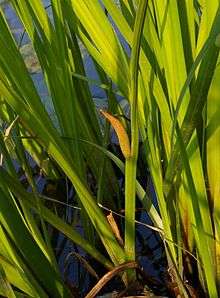Calamus (poems)
The "Calamus" poems are a cluster of poems in Leaves of Grass by Walt Whitman. These poems celebrate and promote "the manly love of comrades". Most critics believe[1][2][3] that these poems are Whitman's clearest expressions in print of his ideas about homosexual love.
Genesis and "Live Oak With Moss"
The first evidence of the poems that were to become the "Calamus" cluster is an unpublished manuscript sequence of twelve poems entitled "Live Oak With Moss," written in or before spring 1859.[4] These poems were all incorporated in Whitman's 1860 edition of Leaves of Grass, but out of their original sequence. These poems seem to recount the story of a relationship between the speaker of the poems and a male lover. Even in Whitman's intimate writing style, these poems, read in their original sequence, seem unusually personal and candid in their disclosure of love and disappointment, and this manuscript has become central to arguments about Whitman's homoeroticism or homosexuality. This sequence was not known in its original manuscript order until a 1953 article by Fredson Bowers.[5]
"Calamus" sequence
In the 1860 third edition of Leaves of Grass, Whitman included the twelve "Live Oak" poems along with others to form a sequence of 45 untitled numbered poems. This sequence as written celebrates many aspects of "comradeship" or "adhesive love," Whitman's term, borrowed from phrenology to describe male same-sex attraction.[6] This attraction is presented in its political, spiritual, metaphysical, and personal phases—Whitman offering it as the backbone of future nations, the root of religious sentiments, the solution to the big questions of life, and as a source of personal anguish and joy.
The 1860 edition contains three poems that Whitman would later edit out of the sequence, including the very personal Calamus 8, "Long I thought that knowledge alone would suffice me," and Calamus 9, "Hours continuing long, sore and heavy-hearted." Whitman's constant editing of his works meant that many of the other poems would change and shift throughout the editions of his life. By the 1881–82 edition, the poems had been reduced to 39. Some critics contented that Whitman's edits tended to reduce some of his most personal and specific disclosures, possibly as an attempt to make the sequence more attractive to its wider audience.[7] Others, such as Betsy Erkkila, note that Whitman retained some equally personal poems for the 1867 edition, and see his selection as a function of Whitman building a particular national persona for himself.[8]
The meaning of Calamus as a symbol

This cluster of poems contains a number of images and motifs that are repeated throughout. The most important is probably the Calamus root itself. Acorus calamus or Sweet Flag is a marsh-growing plant similar to a cat-tail. Whitman continues through this one of the central images of Leaves of Grass--Calamus is treated as a larger example of the grass that he writes of elsewhere. Some scholars have pointed out as reasons for Whitman's choice the phallic shape of what Whitman calls, "pink-tinged roots" of Calamus, its mythological association with failed male same-sex love and with writing (see Kalamos), and the allegedly mind-altering effects of the root.[9] The root was chiefly chewed at the time as a breath-freshener and to relieve stomach complaints.
References
- ↑ Calamus: Male Homosexuality in Twentieth-Century Literature: An International anthology, David Galloway, Christian Sabisch
- ↑ Whitman's "Calamus": A Rhetorical Prehistory of the First Gay American-J. Killingsworth
- ↑ Walt Whitman, Prophet of Gay Liberation
- ↑ Alan Helms, "Live Oak With Moss (1953–1954)." Walt Whitman: An Encyclopedia. Eds. J. R. LeMaster and Donald D. Kummings. New York: Garland, 1998. 400–401.
- ↑ Bowers, Fredson. "Whitman's Manuscripts for the Original 'Calamus' Poems." Studies in Bibliography 6(1953): 257–265.
- ↑ Miller, James E. Jr. "Calamus." Walt Whitman: An Encyclopedia. Eds. J. R. LeMaster and Donald D. Kummings. New York: Garland, 1998. 95–97.
- ↑ Raleigh, Richard "["Hours Continuing Long."] Walt Whitman: An Encyclopedia. Eds. J. R. LeMaster and Donald D. Kummings. New York: Garland, 1998. 282–283.
- ↑ Erkkila, Betsy (1996). Whitman the Political Poet. Oxford UP. p. 261. ISBN 9780195113808.
- ↑ Auclair, Tracy. "The Language of Drug Use in Whitman's 'Calamus' Poems." Papers on Language and Literature 40 (Summer 2004), 227–259.
External links
- Works by Walt Whitman at Project Gutenberg
- Calamus On WikiSource
- Manuscript for "Live Oak With Moss" at the Walt Whitman Archive